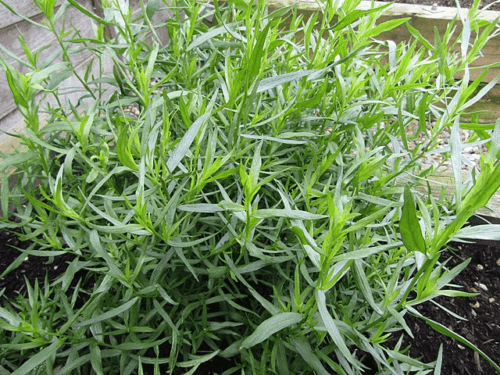Tarragon the Herb and the Dragon

I ran into a reference for an herb called ‘dragon’ and you know what that meant, right? Exactly, another expedition down the research rabbit hole! This is what I learned.
Thomas Jefferson brought the herb tarragon to the US from Europe. The plant he brought was French Tarragon which can only be grown through cuttings, not Russian Tarragon, which can be grown from seeds. Artemisia dracunculus sativa., or estragon, is a perennial herb in the same family as the sunflower. While it is perennial, it is temperature sensitive and cold slows growth and reduces leaf quality.
Tarragon is a foundational herb in French cuisine, found in the fine herbes mixture as well as modern Herbes de Provence blends. Flavor-wise, tarragon is pungent and bittersweet. Many find its flavor rather licorice like, comparing it to anise and fennel, with a bit of grassiness, vanilla, and mint thrown into the mix.

The term “dragon herb” comes from the from the Latin name “dracunculus” and is probably connected to the twisted, coiled root shape. Old cookbooks, especially those with European and French origin often call for estragon or dragon in recipes requiring tarragon.
Traditional herbal medicine uses tarragon is used for indigestion, nausea and vomiting, sleep problems and tooth ache. Little scientific evidence supports these uses. Some believe that “estragon” (tarragon) contains estrogen. But no clinical studies support that either.
Through the Georgian era, many held that tarragon could heal snake bites and ward off serpents and dragons. This might have been because of the gnarled, rather serpentine, roots.
And just for fun, here’s a free pattern for a knitted dragon named Tarragon.
Reference
“Tarragon, The Dragon Slaying Herb.” Goddess Cooks. March 8, 2015. Accessed July 14, 2022. https://goddesscooks.com/2015/03/08/tarragon-the-dragon-slaying-herb/

Comments
Tarragon the Herb and the Dragon — No Comments
HTML tags allowed in your comment: <a href="" title=""> <abbr title=""> <acronym title=""> <b> <blockquote cite=""> <cite> <code> <del datetime=""> <em> <i> <q cite=""> <s> <strike> <strong>